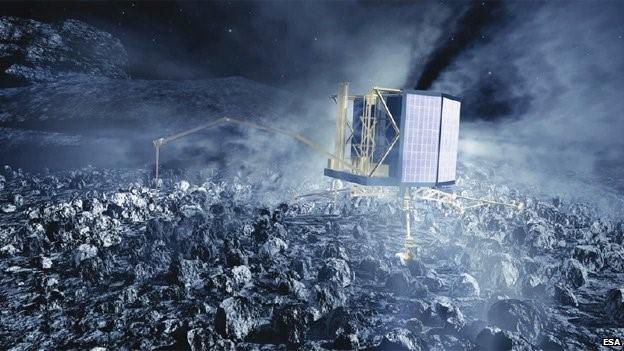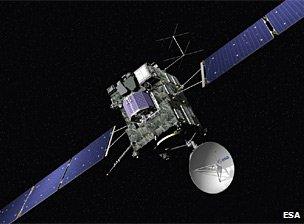Rosetta: Anxious wait for comet chaser wake-up
- Published

Philae will deploy ice screws and harpoons to hold itself down on the comet's surface
Scientists say they are in for an anxious wait as they prepare to wake a comet-chasing probe from deep-space hibernation.
In January, they will attempt to bring the Rosetta spacecraft back online so it can journey towards Comet 67P/Churyumov-Gerasimenko.
Once it has reached the huge mass of ice and rock, the team will try to deploy a lander on the comet's surface.
Details were announced at the American Geophysical Union Fall Meeting, external.
Rosetta's project scientist Matt Taylor, from the European Space Agency (Esa), said: "This has never been done before.
"You have the hurdle of getting it back on. Then there is a massive hurdle of getting it close to the comet. And then there's landing on it.
"This is going to be a year of intensity."
The Rosetta probe was launched in March 2004, and has been on an epic journey through the Solar System.
It has orbited the Earth three times and then performed a slingshot around Mars to place it on a path towards Comet 67P/Churyumov-Gerasimenko.
After travelling many millions of kilometres, and passing two asteroids along the way, the Esa craft was put into deep sleep - that is, the spacecraft is turned off bar its alarm clock - in June 2011.
This has enabled it to conserve its power for the final, risky stages of its journey.
Waking it up again will be "nerve-wracking", Dr Taylor told the BBC.
"It has an internal alarm clock. The clock will say 'it's time to wake up'," he said.
This will happen at 10:00 GMT on 20 January. However, it could be a slow process - as if the craft is hitting snooze a few times after such a long slumber.
The on-board electronics will be the first to warm up and then the "star trackers" should begin to establish Rosetta's position.
The craft will then have to right itself, stabilising from the slow spin it has been performing while in hibernation mode.
"By the evening - that is when the first signals will be beaming back to Earth. Hopefully we will receive them," Dr Taylor said.
"But it's going to be a very slow day - I imagine there will be lots of scientists pacing up and down while we wait."

Rosetta was launched way back in 2004
This week, Esa launched a social media campaign to build excitement around 20 January.
It is calling on people to make a video clip of themselves and friends shouting "Wake up, Rosetta!". Prizes are being offered for the most imaginative videos shared via the dedicated Facebook page, external.
Sun seeker
If Rosetta can be revived, it will push forwards towards the comet, which has a core that is about 4km wide (2.5 miles).
It should meet the object in August and spend some weeks hurtling alongside.
In November, the most perilous stage of the process will begin as the team tries to deploy a robotic lander - Philae - on to the icy surface.
"We've got loads of people working on this to make sure the trajectories are correct," said Dr Taylor.
But he said it was a risky manoeuvre that had never before been attempted.
If the landing is successful, the robot will take samples and record images as the comet makes its closest approach to the Sun in 2015.
It is hoped this will reveal more about these mysterious icy bodies, which are some of the most primitive objects in the Solar System.
Follow Rebecca on Twitter, external
- Published18 September 2013